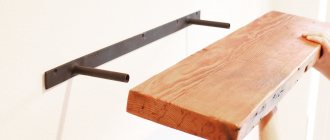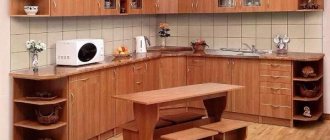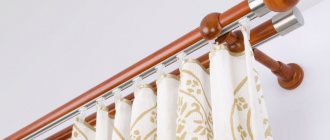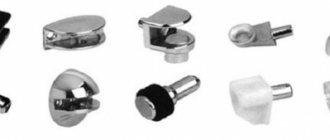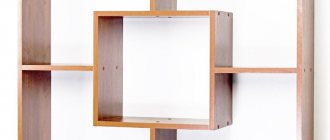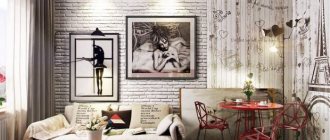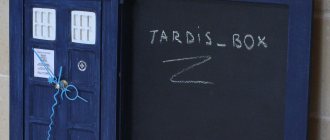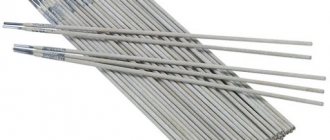Hi all! Creating a beautiful and practical interior in a frame house, in a country house or in an ordinary high-rise building often becomes the task of the immediate home owner. One of the pressing issues is how to hang a shelf on the wall.
This procedure may seem extremely simple and mundane. But not everyone knows how to act so that the fasteners are not visible, or what to do correctly if the walls are made of PVC, that is, of plastic panels, brick, shingles, lining and other common materials.
Today I will try to answer key questions, talk about the features of installing shelves and existing installation methods. You will get some answers from the video. And if you still have questions, you can always ask them in the comments.
How to hang a shelf on a plasterboard wall
Recently, this material has been offered so widely that manufacturers have begun to produce fasteners and entire systems specifically for it. Since drywall works extremely poorly in bending (fracture), conventional installation approaches are not suitable here.
Today, drywall is often used for finishing. Butterfly anchors are used for this material.
Typically, the following methods are used:
- Special fasteners. A shelf that will not be heavily loaded can be hung using special fasteners such as a molly or butterfly screw.
- Creation of a power frame. In some cases, sheets of drywall are installed on a special frame. The product is attached to it directly, however, for this you need to know the features of its design.
- Directly. If the sheets are a short distance from the main surface, hanging can be done directly to the wall using anchors.
Anchor reinforcement is used to secure shelves that can support significant weight.
Common mistakes when installing shelves
Inexperienced people may hang the shelf incorrectly, and errors will appear after installation is completed. To avoid this, remember that:
- The length of the drilled hole should be slightly longer than the length of the screw.
- Foam concrete is a rather low-density material, so ordinary hardware cannot be used for fastening. They will not stick to the wall, moreover, they can destroy it. Plastic dowels, metal fasteners and chemical anchors should be used.
- If the load vector is directed perpendicular to the axis of the drywall sheet, the wall will simply break. To avoid this, special dowels for drywall are used: Driva dowel, butterfly dowel and Molly anchor.
- Heavy structures are attached exclusively to load-bearing walls.
- You need to carefully select fasteners that will match the type of shelf and be suitable for the wall material.
Fastenings for shelves on a tiled wall
In the bathroom, it is sometimes very difficult to hang a shelf on the wall due to the fact that it is tiled. Such tiles, if you start drilling them, quickly begin to crumble. Therefore, many people ask the question: “How to attach a shelf to a tiled wall?”
When installing a shelf on a tiled wall, it is important to drill the tiles with a drill at low speeds
Due to their design and other qualities, corners are one of the most reliable types of mounting a shelf to a wall.
The shelf is attached to a wooden wall using conventional self-tapping screws.
In order to attach a shelf to a tiled wall, you need a set of necessary tools. The only thing you need to buy additionally is drills with carbide surfacing. During drilling, all the glaze is removed from the tile and the core of the tile is drilled at low speed.
After this, a drill of a smaller diameter is taken and the wall is broken down to the required size. Next, the bracket is installed. After this, you can attach the shelf to the tiled wall.
Safety precautions when installing shelves
To avoid injury and damage, you must strictly follow safety precautions. Before starting installation, be sure to:
- Wear gloves, safety glasses and a mask.
- Check the power tool: there should be no mechanical damage. Before you start drilling into the walls, check if it works well.
- Make sure that there is no electrical wiring in the place where you plan to hang the shelf.
- The workplace must be comfortably equipped. Remove all objects that may interfere.
What fasteners to use for glass furniture
Modern models consist of many glass and glossy panels. To fix them, special types of fasteners are used. Silicone and rubber gaskets help reduce friction.
They prevent damage to the glass panel during the assembly process. Most of the parts are glued with a special adhesive. The fittings consist of lightweight metals. Thanks to this, all the details are in harmony with each other. Hidden furniture fasteners are used here.
For larger models, corners, hinges and locks are used. Thin screws and self-tapping screws with plastic attachments help secure these elements.
Rules for fastening shelves and necessary tools
The method of fastening the shelves is chosen taking into account:
- Base material. Any fastener can be fixed on brick, wood and concrete surfaces. For plasterboard and paneled walls, invisible fittings are used, which can be fixed in the frame (wooden blocks or metal profiles).
- Shelf material and thickness. Glass structures are fixed with holders, metal ones are hung using hidden hinges, and wooden ones or those made of laminated chipboard are hung on rods. Thin products are hung on small corners or loops made of any material, massive ones - on durable metal ones.
- Length of the hanging structure. Typically, 2 fasteners are used, placing them at some distance from the edges of the shelf. However, long shelves (one meter or more) will require additional support.
You also need to consider the thickness of the wall. If it exceeds 25 cm (for brick) or 10 cm (for concrete), then the invisible fastener can withstand heavy loads. When installing on thinner partitions, as well as walls made of wood or gypsum board, you need to understand that the shelf will perform an exclusively decorative function; placing heavy objects on it is prohibited.
Tools
To independently attach shelves to the wall without visible fasteners, you need to prepare everything that is required in the process:
- building level;
- drill or hammer drill (these tools are needed for drilling holes);
- mallet or hammer;
- screwdriver;
- ruler;
- marker;
- accessories;
- dowels, furniture screws or self-tapping screws.
Installation rules
First, mark the line on which the fasteners for the shelf to the wall will be installed. A level is applied to the surface at the desired height and its position is leveled so that the bubble is located exactly in the center. Make a mark with a marker.
Drill holes in the wall at the designated points. For hard materials (brick, concrete), it is preferable to use a hammer drill. The drill is suitable for working with wood or plasterboard. Plastic dowels are driven into the holes using a mallet.
The next step is to install a self-tapping screw into the dowel if hinges or strips with metal rods are used. Single rods are screwed directly into dowels instead of self-tapping screws.
Proceed to the installation of the shelf:
- On the rods. You need to drill a hole of equal diameter and length in it, and then attach it to the fittings.
- On the hinges. The hinges are screwed to the rear end of the suspended structure. And then the shelf is attached to the wall using pre-screwed screws.
Afterwards, check the evenness of the installation using a building level - place it on a shelf and look at the position of the bubble. If it deviates, you need to correct the position of the product, otherwise the objects placed on it may fall. When everything is aligned, check the reliability of the fastening by placing an object on the shelf whose mass is equal to the permissible load.
Features of houses made of monolithic concrete
In order to comprehensively study the pros and cons of living in a residential apartment of a monolithic frame house, this article will consider some aspects of arranging life in a room with concrete walls.
The reader will also be presented with brief instructions that describe how to prepare a room for wallpapering. In addition, here you can see recommendations on what to drill a hole with before hanging a shelf on a concrete wall, as well as some other useful tips.
Construction of a residential building using monolithic frame technology.
Types of concrete wall panels
Having settled in a new house, before carrying out repairs or starting work on the decorative design of the home, you should understand that not all wall panels of a residential apartment must necessarily be made of monolithic reinforced concrete.
In modern construction, there are several technologies for using concrete mortar in the construction of residential buildings and structures.
- External and internal load-bearing walls, as well as interfloor ceilings, are most often made using monolithic frame construction technology from high-strength reinforced heavy concrete of the appropriate grade and strength class.
- Internal walls and interior partitions, provided that they are not load-bearing structures, are usually constructed from various types of lightweight concrete.
- For the manufacture of technological partitions and thermal insulation elements, building blocks made of ultra-light gas-filled cellular concrete can be used.
The photo shows an interior partition made of lightweight concrete.
Note! In addition to monolithic frame construction, there is also a technology for constructing external walls and load-bearing structures of buildings from prefabricated blocks or panels, which are also made from heavy grades of structural concrete.
Advantages and disadvantages
Like any building material, each type of concrete wall panels has its positive and negative sides.
- Monolithic panels are distinguished by very high strength, durability and load-bearing capacity, they are well resistant to moisture, high and low temperatures, as well as other atmospheric factors, therefore they are used for the construction of external and load-bearing walls of buildings . However, due to their high density, these materials have low thermal insulation ability and therefore require additional thermal insulation.
- Interior partitions and internal walls are designed for low loads , but even with a small thickness they have high heat and sound insulation properties, and are well suited to drilling and other types of mechanical processing without the use of special tools.
- Structural elements made of gas-filled cellular concrete are not designed to withstand load-bearing loads , but at the same time, very low thermal conductivity and low price make it an indispensable material for arranging thermal insulation of building structures. This material is very easy to machine, but before applying the topcoat it requires continuous puttying to seal open pores.
Mesh metal shelves
Most wardrobe systems for wardrobes involve storing things on mesh metal shelves. And this is quite justified and reasonable: thanks to their cellular shape, mesh shelves allow air to pass through perfectly and promote good ventilation, eliminating the possibility of a musty smell inside the cabinet.
Also, mesh metal shelves increase the viewing angle inside the cabinet. For example, in the hallway:
- All the shoes on the lower shelves are clearly visible through the bars. Therefore, it is recommended to make shoe racks from metal shelves (in addition, they are easy to clean).
- You won’t have to “rummage” with your hand in search of a headdress on the top shelf if it is mesh. You can clearly see what lies where above eye level.
However, metal mesh shelves also have a weak point. This is not such a strong attachment to the frame as with blank shelves made of chipboard and MDF. It is also not recommended to heavily load the grids.
Methods for attaching mesh shelves
There are two types of fastening of metal shelves: wall or side.
In the first case, the shelves are attached to the wall, that is, to the back of the wardrobe, using special brackets and guides.
The installation can be strictly horizontal or tilted if these are shelves for shoes.
The front edge can be reinforced using special support posts.
You can also purchase special canopy holders for hanging the barbell under hangers.
Or dividers-partitions for deep shelves. This will allow you to more accurately store various small accessories and items.
Shelves with side fastening are installed in the same way as regular ones, with emphasis on the partitions. To do this, the shelf is cut to the size of the allocated niche and secured using special stop holders.
There is an option for mounting on special runners. Then the mesh metal shelf can be retractable.
You can also install dividers on it for optimal zoning for storing small items.
What to consider when installing shelves
Before hanging a shelf, you need to pay attention to some installation nuances:
- Approximately determine how much load will be placed on the shelf.
- What will the shelf be used for?
- What type of fastening is required?
The most important thing here is the load. The type of fastener, installation method and location of the shelf depend on it. Large wall shelves require much more secure mounting than small plastic decorative shelves. Another feature is the purpose of the shelf. It should be located at a convenient height so that each family member can easily get the necessary thing. If you are equipping a home library, those books that are rarely read can be placed on high hanging shelves. But it is better to store your favorite literature in a rack.
Consider shelving as a way to zone a room. This technique is relevant in studio apartments, where you need to divide the space into several work areas. Shelving easily copes with this and can separate the kitchen from the living room, the bedroom from the nursery and any other areas.
In a children's room, the height of the shelves is responsible not only for convenience, but also for the safety of the child. They should be a little taller than his height, but not too low, because the baby is growing quickly. The most practical option is a small floor rack. Place your child's favorite toys on the bottom shelves so that he can easily reach them, and on the top - what he uses least often.
Sequence of work
Before you attach the shelf to the wall, you need to know that the thicker the shelf, the thicker the support should be. A hole is drilled in the end part an average of 5 mm below the surface. All holes for shelves in the wall must match, otherwise attaching them will be quite problematic.
Metal corner - the most reliable fastening for a wooden shelf
When using anchor bolts, you can use special brackets
Invisible fastening of shelves is carried out in a hidden way
Using your imagination, you can create a unique shelf fastener
Attaching the shelf to the wall:
- A strip of the required length is considered a template. It is applied to the end of the shelf and a hole of the required diameter is made, after which it is applied to the wall.
- The next step will be drilling, which must be done with maximum precision.
To attach the shelf you will need:
- electric drill,
- threaded coupling,
- brackets,
- lath - template,
- carpentry glue,
- screws.
Choosing fasteners for shelves in hollow brick
Tip: When choosing fasteners for a brick wall, you should take into account the type of brick that was chosen for masonry: hollow or solid, its type, grade and strength.
In addition to the type of building brick, the strength of the shelf fastening is influenced by the method of carrying out the work. For example, the most popular method using a hammer drill cannot be used in this case.
Tip: When working with hollow brick partitions, you should only use drilling holes. At the same time, it is necessary to constantly monitor the process so that chipping of the edges and cracking of the bricks does not occur.
Fasteners for hollow bricks pose particular problems. It is very difficult to attach heavy objects to it, which is simply necessary.
This can be done in several ways:
- A hole is drilled in the wall into which a wooden peg is inserted and a screw is screwed in. This method can be used by driving a small number of nails - one or two - into the brick wall;
- When using 10 or 20 elements for installation, you can use corners and attach them to a brick wall, placing a shelf on top;
- Fastening to a brick wall is best done with dowels, which are tied into a knot directly in the void.
How to hang a shelf so that the fasteners are not visible
Depending on the specific type of hidden fastener, the stages of work may be different. In any case, you need to prepare the tools in advance (a hammer or drill, drills, a level, a square, drills, a marking pencil, a rubber hammer), and also choose the place where the structure will be installed.
Hidden hinges
This option of hidden fasteners is the most popular. In this case, hidden loops are used, which are located on the back side of the shelf.
They act this way:
- Measure the exact distance between the center of the hinges in order to correctly mark the fasteners on the wall.
- To avoid skew and uneven positioning, all actions are controlled with a building level in the horizontal plane.
- Using a drill, the corresponding holes are made, cork pegs are inserted inside, into which the screws are deeply screwed.
- As a result of the manipulations, the screw should be positioned so that hinges can be secured between its head and the wall.
- Fix the hidden hinges in their proper place and hang the structure.
Hanging a shelf with hidden hinges
Special furniture fasteners
Often, fastening elements are sold with ready-made shelves, which are designed for invisible fixation of products. They are easy to use and reliable, but they are not always included in the kit.
Advice! With the help of such fittings you can also create the impression of products floating in space, if this “highlight” is intended by the design project.
Shelves with a set of invisible fasteners
Installation is carried out as follows:
- Measure the distance between the holes for the fittings that are on the shelf.
- Make markings on the wall so that the two groups of holes coincide exactly, check all actions with a building level (the ideal option is to use a laser level).
- Drill holes for attaching brackets strictly perpendicular to the wall so that the shelf in the future becomes exactly at an angle of 90º (use a square when drilling).
- Crumbs and dust are removed from the drilled holes and plastic dowels are inserted.
- Attach elements of invisible fasteners with self-tapping screws.
- The shelf is placed on the axes of the brackets, carefully tapping it on the left and right so that it stands without distortion.
- Check the reliability of fixation.
Metal rods
These rods are pins that have a thread on one side and a smooth surface on the other. Each pin is threaded into the wall, and the smooth side is inserted into the shelf.
For the job, select a drill of a suitable diameter (the same as that of the rods). Apply markings on the shelf and on the wall.
Holes for pins are made in the end part of the product (the depth should be equal to the part of the pin that fits inside the shelf). Then, using a hammer drill, holes are drilled in the wall according to the markings.
Hidden shelf support
The rods are inserted into the holes, knocked down with a hammer, or screwed in with a key. Align the holes and fittings and place the product on the rods.
Advice! To enhance the reliability of the fasteners, you can add a little glue inside the holes.
Working with foam block surfaces
Foam block is quite good as a building material, but it is quite difficult to do additional work with it. It is characterized by increased porosity, hygroscopicity, and low density. Hanging a shelf on such a wall is not an easy task. The fastener should not just be screwed into the wall, but create auxiliary support.
The following are used as fasteners:
- Dowel - choose either metal or nylon, with a specialized spacer at the end. The hole is drilled with a screwdriver and a dowel is inserted into it.
- Dowel nail – suitable for installation of wooden, plastic, metal, aluminum structures. This nail has ribs; they secure the fastener inside the foam block.
- Anchor – differs from that used in other wall structures. In this case, it has a spacer shape.
- M4 screw with a metal spacer.
- Self-tapping screws - they are used only in dense areas of the block.
Today, the most reliable type of fastener for foam and gas blocks is a chemical anchor. It is frost-resistant (suitable for external work), can withstand heavy loads, and is universal.
What information do you need to provide to start working on the project?
We need to receive your terms of reference, but if you don’t have it, then at least the following preliminary information:
- warehouse plan, which specifies the dimensions of the grid of columns, the presence of links to doors, gates, windows, and designated communications;
- information on permissible loads on floors, floor materials and their condition;
- description of the stored goods (container, dimensions, weight, packaging units, frequency of movements, etc.);
- data on existing warehouse equipment or planned for use (load capacity, lifting height, width of the working corridor, dimensions, model, etc.);
- information about the mandatory organization of areas for acceptance, packaging, shipment, and others (if such areas are already organized, then information is needed about their configuration and area);
- indicate, if any, specific requirements for the racking system.
Installing shelves
The shelves are placed on brackets and pencil marks are made through the mounting holes on the bottom of the shelves. Next, holes of the appropriate size are drilled at the marks on the bottom of the shelves.
The flat screws are threaded through the holes in the mounting bracket and into the pilot holes on the bottom of the shelves. During the work you will need the following tools:
- hidden wiring detector (Stud Finder);
- roulette;
- electric drill;
- drill of the required diameter;
- flat head screws;
- level (carpentry);
- shelf brackets;
- shelves.
It is recommended to use hollow anchors to attach shelves when the studs are not in the correct location to accommodate the length of the shelves. It is helpful to have a helper to hold the shelves in place while the holes are made in the wall. Be sure to wear safety glasses when drilling holes.
Advice and recommendations from experts
Although attaching a shelf is not the most difficult task, there are some installation rules. Adviсe:
- Do not install the shelf too high or in a place where it may interfere with movement.
- To install the shelf level, a piece of electrical tape is glued to the level at the attachment point.
- Use stronger fasteners when installing the shelf on a gypsum fiber board wall.
- Correctly calculate the number of fasteners and the load on the structure.
- When drilling a hole for a dowel, use a drill with a diameter equal to the size of the sleeve.
When preparing holes in the wall and shelf sheet, it is important to keep the drill level, otherwise the screws will not hold tightly, which will cause the structure to fall.
Attaching various shelves to the wall. Useful tips
In order to properly attach the shelf to the wall, you can use the following guidelines:
- both the bracket and the corners for the shelf must be securely fastened;
- each bracket for a removable system must be wide to firmly hold the shelf;
- all screws and other fasteners for various shelves to the wall must be correctly selected when purchasing;
- each purchased bracket must match the type of racks and shelves;
- fasteners for various shelves to the wall must correspond to the depth, width and height of the shelves themselves, as well as the weight of what will stand on them;
- Before ordering a wall mount for each shelf, you need to double check all measurements.
Fixed bracket and shelf mounting
The bracket is available in a wide variety of types. First of all, you need to understand how many of them you will need. Then it is determined how each bracket will be located on the bottom surface of the shelf. Holes are drilled and any fixing devices are inserted into them. After this, you need to screw the shelf using self-tapping screws.
The fixed bracket for attaching shelves to the wall has a wide range of varieties and different fastening technologies
When attaching a shelf with hidden fasteners, it is very important to maintain the exact distances between the holes
Modern types of furniture fasteners
Specialized departments offer many types of furniture fasteners. Almost all of them belong to the same type, this is a threaded screw. The design consists of a wide bolt and nut. During the assembly process, they tightly fix the various parts together. They are used to make kitchen tables, cabinet and upholstered furniture.
- bolts with driven nuts. The main advantage of such products is their reliability. The product is strong;
- confirmation It belongs to the screw type of fastener. The principle of operation resembles self-tapping screws or a hex screw. These products ensure quick assembly of the furniture structure, as well as its aesthetic appearance;
- eccentric couplers. Almost all high-quality products consist of such elements. They provide good fixation of each part. In addition, they allow you to increase the speed of assembly;
- wooden corners. This type was used more than ten years ago, but due to their reliability they are used for the production of modern furniture.
The stores offer a catalog of furniture fasteners. It concentrates more than 100 types of metal products for the production of one or another type of furniture paraphernalia.
Hidden
Hidden fastening for shelves is a solution for interiors decorated in high-tech, minimalism or modern style.
To install shelves on the wall use:
- Hidden hinges. They are suitable for products of different thicknesses and materials (chipboard, solid wood, plywood). Using a building level and a marker, mark points on the surface of the wall and drill holes for fasteners. Then the dowels are driven in and the hinges are secured with self-tapping screws. At the end of the shelf, with which it will adjoin the wall, it is advisable to make a recess to the size of the hinge, so that due to the protruding fittings, no free space will form between the wall and the shelf.
- Metal rods. This type of fastener belongs to the console type. It is usually sold complete with the shelf itself, in which holes of the required diameter and depth are already made. The method of fixation may vary - either it is screwed into the wall with a dowel, or it is attached to flat hinges or strips. Reliable fixation is ensured only by those hardware whose diameter is at least 10 mm.
- Wooden beam. Used for installing closed shelves. On the wall, using a level and a marker, draw a line on which the auxiliary fasteners will be placed (it should go under the shelf). Then the block is attached using dowels and screws. Hang the shelf and secure it with an additional block.
Types of fastenings
Hidden
The choice of hidden shelves is usually determined by the style of the room. Since this method is quite labor-intensive, preference is given only in cases of urgent need. This type of installation creates a feeling of lightness of the structure, expanding the space of the room. It is often used as an interior element in minimalist, ethnic Asian (Japanese, Chinese, Thai), modern, and high-tech styles.
Hidden hinges
They can be used for wooden shelves, laminated chipboard, plywood. The hinges are attached to the back of the shelf with self-tapping screws according to the markings. If this is a home-made product, then it is better to make indentations (cuts) in the places where the hinges are attached, according to the size and thickness of the fastening fittings, so that the hinges are flush with the edge of the product and tightly adjacent to the wall. Now you can hang it on the wall using screws screwed into it in advance.
Metal rods
Now there is a large selection of console mounts on the market; ready-made shelves of various sizes can be selected with them. The design includes a hidden shelf holder for a wooden shelf and a bracket for attaching the shelf holder to the wall.
This method provides for the presence of holes in the shelf into which metal rods of furniture fittings will be inserted, and the rod should be 2-5 cm shorter than the product itself.
At home, you can construct such a cantilever mount yourself, using pieces of reinforcement and threaded rods complete with drive-in anchors as metal rods. And in the shelf itself, you need to drill holes in the size corresponding to the rods, observing the rule that they should be at least 2-5 cm shorter than the width of the product. In this case, the thickness of the rods ranges from 10 to 18 mm, depending on the weight of the future filling.
Wooden blocks
This method of fastening involves installing a frame made of wooden blocks, most often of square or rectangular cross-section, on the wall, and then stringing a shelf on them, which is a hollow structure (box). For reliability, the parts are secured with self-tapping screws; additional elements can be attached with glue.
Brackets, fasteners, corners
When choosing fastening with brackets, you must keep in mind that the fastening elements will always be visible. And this method may well become a decorative element in the interior.
After all, there is a wide variety of shapes, styles, and materials for making brackets. And therefore, shelves on brackets are used in interiors of classic, rustic, modern, modern, shabby chic, loft and other styles.
The choice in favor of such fasteners can be made not only because of their decorative appeal, they can provide reliability under significant loads - up to 30-50 kg.
Models and designs of brackets, materials for their manufacture and materials for shelves for which they can be used are quite diverse. Therefore, it will not be possible to give general recommendations on how to attach them.
But recommendations for installing shelves on brackets on the wall will be given below.
Non-standard methods
In addition to the standard, well-known methods for installing shelves, original options using various available materials are used. These details not only allow you to conveniently and easily fix the structure, but also act as decoration.
Rings with hooks
You can hang the shelf using rings with attached hooks. The rings are attached to the wall, and the hooks are attached to the loops that are screwed into the structure in advance.
Water pipes
The method is useful in any room. Holes are made in the furniture fabric slightly larger than the diameter of the water pipe. The shelf is “put on” and fixed with a flange in the desired position. The design may consist of a single panel, or it may be an open shelving unit.
Belts
Shelves suspended on belts look original. To do this, take two leather products of the same length, fold them in half and drill them towards the wall. A shelf is inserted into the resulting loops. To prevent the canvas from moving, the straps must be screwed to the shelf with small self-tapping screws.
Ropes
Shelves hung on ropes will look great. A thin rope is used for this. 4 holes are made in the tree through which the rope is threaded. Knots are tied on both sides, thus fixing the shelf. The ends of the ropes are tied together and attached to the wall.
Hidden fasteners in books
The shelf is an old book with a metal corner screwed into it. The second part of the fastening is fixed to the wall. This shelf will hold several more books.
Shelf holder in the closet: care and operation
As such, there are no special rules relating exclusively to the care of fasteners. Unless the plastic corners and tension sleeves are kept clean. The mode of operation is more important here. For example, a connection with Euroscrews does not tolerate loads in a perpendicular plane.
There are no special requirements for the care of fasteners. Minifixes, conical ties and especially rafixes have a greater degree of resistance. The weakest point of such fasteners is the cutouts for the pin. Therefore, you should not load the shelves more than usual. In addition, it is advisable not to allow excess humidity in the room, as this does not have the best effect on the mechanical properties of wood.
If the shelf is properly attached, it will last a very long time. Based on the large selection of available fasteners and auxiliary accessories, solving problems with installing a new shelf or fixing a broken one should not present much difficulty. Moreover, using original fastenings for shelves in the closet, you can try to optimize the internal space so that everything you might need fits there.
Concrete wall in a residential building: advantages and disadvantages, repairs
In the construction of modern houses, one of the most popular materials is concrete mortar. If previously it was used only for pouring foundations, now it is used to make almost all load-bearing structures of a building.
Ease of use, wide availability and low cost of this material have led to the fact that most modern multi-storey buildings are built using monolithic frame construction technology, so a concrete wall, as well as the floor and ceiling, is present in almost every residential apartment.
Original concrete wall decoration in a modern interior.
However, when moving into a new house, not all residents understand where to start renovating an apartment or, for example, how to hang a carpet on a concrete wall.
Is it possible to hang a shelf without fasteners?
Most likely, it won’t be possible to do without fasteners completely, but hiding it is quite possible. In this case, several of the most common installation methods are used:
- On the brackets. The fasteners are selected in such a way that after the canopy, the shelf structure hides it from view.
- Using hidden loops. The possibility of choosing this method is determined by the design features - the hinges should not protrude beyond the structural elements.
- With pin fit. An interesting solution that allows you to attach a product consisting of just one element - a load-bearing surface. In this case, the power element, the pin, is fixed directly in the body of the shelf.
- On glue. Installation is carried out by gluing the structure to the wall surface. It is rare due to a number of restrictions.
Using this method, you can hide the fasteners, and the structure on the wall will look light and elegant.
What kind of fasteners for shelves on the wall are there: types by type of fastening
Mounts for wall shelves are divided into two types: for open and hidden (secret) installation
The second option is more difficult to implement; it is used when it is important that the fasteners do not take up space on the wall or are simply invisible; it is only suitable for products made of wood, chipboard, and MDF. All types of fastenings are fixed to the walls with self-tapping screws and dowels, in difficult cases (plasterboard, thick layer of plaster, etc.)
etc.) anchors.
There is an opinion that it is better to use wooden plugs (chops) instead of dowels, but professionals say that wood, sooner or later, dries out.
Hidden fittings without visible fastening
Visually, hidden installation adds lightness to the structure and expands the space. There is no need to match holders by style, color to shelves or furniture.
Types of fastening for hidden mounting of wall shelves:
- Rods. Under them, holes are drilled in the shelf itself with a depth of 2-5 cm shorter than the width of the product. Fastenings of this type can be made independently from steel reinforcement or using threaded rods with anchors. The diameter of the rod (at least 10 mm) is selected taking into account the expected load and the weight of the product itself. There may be a plate at the end of the rod; there are options with two or more rods on one common bar.
- Plates. They are hung on screws and dowels screwed into the wall. This option is used for attaching two- or multi-level shelves and open wall cabinets.
- Wooden bars. They make up a frame and attach it horizontally to the wall. A shelf consisting of two boards and side walls between them is put on the fixed grille as a cover.
- Hidden hinges.
Open shelves, fixed in a secret way, seem to grow into the wall, without any support. That's why they are called "floating".
Exposed Fasteners and Brackets
The standard way to hang shelves is to use regular visible fasteners. They are mounted on the wall under a shelf. Disadvantages - they take up space, sometimes it is difficult to choose a good combination with the material and color of the attached product.
Types of open holders for wall shelves:
- Corners (simple brackets). Maximum load is 20 - 40 kg, the exact value depends on the design and fastening material.
- Reinforced brackets. They differ from the usual ones by the presence of a jumper between the vertical and horizontal parts of the corner. Permissible load up to 100 kg.
- Decorative (mensolo holders). This is a type of corner, the maximum load is from 10 to 30 kg. A distinctive feature is its attractive external design; such a holder can become an independent interior detail. They are selected to match the style of decoration and furniture in the room - antique, modern, techno, etc.
- Reiki. They can be made of wood or metal, installed horizontally (under one shelf) or vertically (under several levels).
Corners and reinforced brackets are usually used in utility or auxiliary rooms; decorative mensolo holders are more suitable for living rooms and offices.
How to choose the right fastening method
Depending on the material from which the shelf is made, the method of fastening is chosen. In this case, not only the weight of the objects that are planned to be exhibited is taken into account, but also the weight of the canvas itself.
Wooden
To attach wooden shelves, a hidden installation method is often used. It is easier to make holes in wood or screw in self-tapping screws. The installation of such shelves on a wooden beam matched to the tone of the furniture will be invisible.
External fastenings include brackets made in a classic style, with ornamental elements, painted in copper or bronze color.
Glass
Glass shelves are installed on pelican brackets. The panel is clamped between two holder parts installed one above the other. It is possible to use metal slats in which the shelf is clamped in a similar way.
To install corner shelves, use any method. Only during the installation process is it worth considering that the fasteners under the canvas may intersect due to their length, so you need to select their size correctly.
Metal
To fix metal shelves, metal corners are used. However, they have a low load capacity, so for heavy structures frames made of metal slats are used.
Plastic
Plastic shelves are light enough, so they can be mounted on any holders. But if furniture is installed on a wall covered with tiles, it is better to avoid repeated drilling.
Complex cases
There are a number of cases when attaching shelves to the wall requires care, some effort, or the use of more durable materials.
How to hang a glass shelf
Glass shelves are installed on brackets. The fastenings are fixed to the wall with ordinary self-tapping screws and covered with decorative overlays on top. The glass is clamped between two parts of the bracket using a compression mechanism.
On a plasterboard wall
To firmly install shelves on a gypsum plasterboard wall, it is necessary to make embedded parts from metal or wood at the installation stage. In this case, the fasteners will be screwed to a durable material and hold the structure tightly. If the wall is hollow, it is better to install the shelf using umbrella dowels.
Concrete wall
A special feature of a concrete wall is its strength, so installing a shelf will require drilling. To do this, use a hammer drill and a durable drill of a slightly smaller diameter than the dowel-nails that will be used.
Types of fastenings for different shelves
There are three main types of shelves used in modern furniture:
- Wooden. The material is chipboard or MDF. The most common type.
- Glass. Manufactured from tempered glass through special thermochemical treatment. As a result, additional strength is provided, which allows them to be used in furniture production.
- Mesh or wire. They are a wire frame in the form of boxes or baskets.
Today, shelves are made from almost any material, including glass.
Shelves can have various modifications, including retractable mechanisms.

